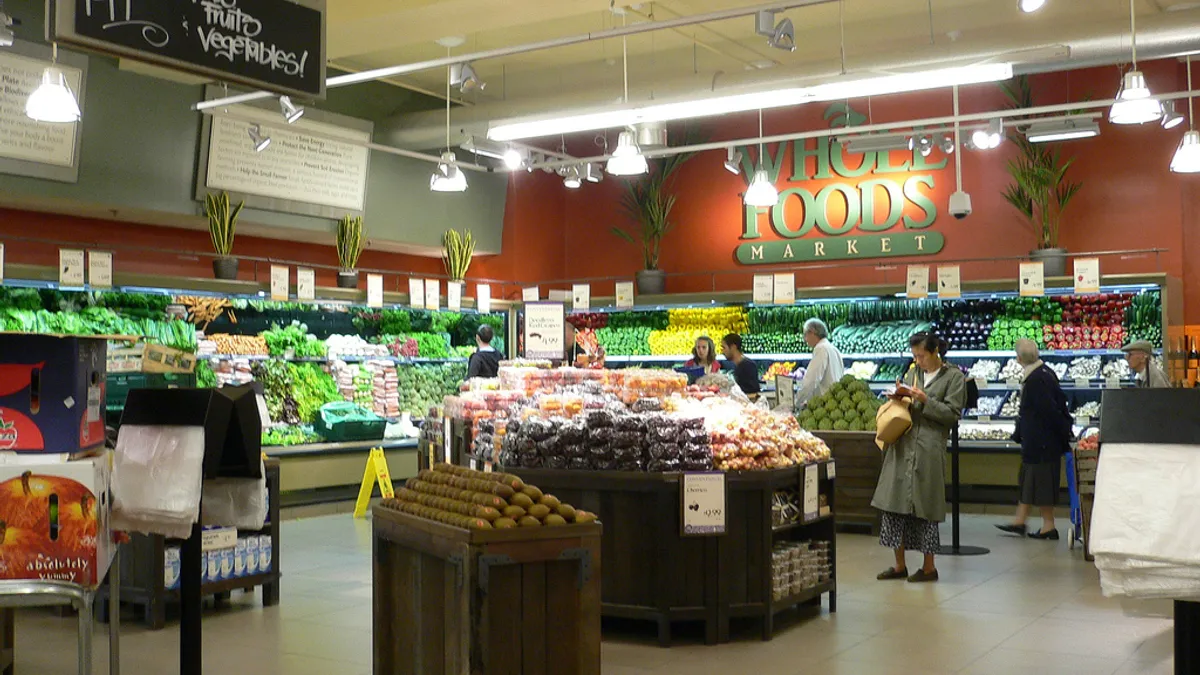Dive Brief:
- Business Insider compared identical baskets purchased at Whole Foods this summer and from two years. The publication found a negligible difference in price between the two receipts. A reporter purchased 29 items at a location in Richmond, Virginia for $147.77, just $2.26 below the price total from 2015.
- Prices on 11 items were unchanged, while fresh meat and dairy items were significantly lower than they were two years earlier. A pound of ground beef cost 21% less, while a carton of eggs was 19% less. However, a bottle of olive oil cost 49% more than it did in 2015, and a jar of peanut butter cost 20% more.
- Analysts say Whole Foods has made modest but inconsistent changes to its prices. According to one analyst, prices are coming down but not enough to move volume, which “squeezes profitability.”
Dive Insight:
Although Business Insider compared current and past prices at a single Whole Foods store in Virginia, the results are consistent with what industry observers say they are seeing across the chain. Whole Foods has lowered prices — but only on certain items, and not enough to alter its high-price image. This means the company is earning lower margins without gaining volume, according to Neil Saunders of GlobalData Retail, who called this “the worst of all worlds."
A more expansive study conducted last year by Wedbush Securities found Whole Foods’ prices are, on average, 15% more expensive than competitors such as Kroger or Safeway.
This goes against what Whole Foods has promised its investors during the past two years. Back in 2015, after the natural and organic grocer’s profits began to slip as mainstream competitors moved in on its turf, CEO John Mackey and team set out a strategic plan to return to growth. This plan included addressing its “Whole Paycheck” image — a phrase that rankles Mackey and other Whole Foods execs — by lowering prices. It also called for the retailer to cut costs, centralize its buying process and increase promotions.
Lowering prices to the extent that Whole Foods needs to while still maintaining profitability is very difficult. It requires a steady, organized effort that moves the dial without disrupting sales too much. Under pressure from activist investors Jana Partners and Neuberger Berman, Whole Foods may have been reluctant to lower its prices too much and see profits slip further. Instead, it opted for price drops on select items that bring high-value customer into stores.
A recent trip to a location on Manhattan’s Upper East side revealed price drops on everything from beer to baby food to cereal — all items that frequently drive trips. Sale items had bright yellow tags displaying the new price along with the former cost.
The good news for Whole Foods is that Amazon, which recently announced it would buy the grocer for $13.7 billion, can help improve its prices. With its deep pockets, the online retailer can absorb the sales hit Whole Foods takes as better volume sales gain traction. Amazon also can enact deep price cuts faster than the retailer likely could on its own.
Industry analysts expect pricing to be one of Amazon’s first priorities for Whole Foods when and if its acquisition goes through later this year. Amazon also brings a wealth of technology, efficiency and e-commerce expertise that could benefit the once dominant grocer. At the same time, Whole Foods is the expert in brick-and-mortar grocery, and will need to help itself if it hopes to return to industry prominence. The company simply can't afford to fall behind in such a competitive market.










